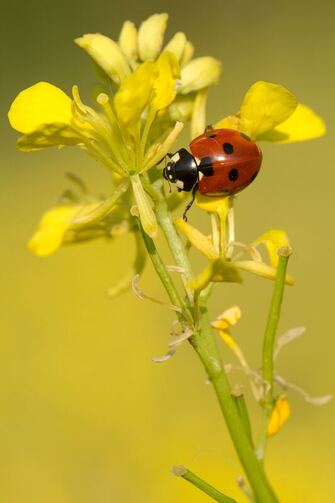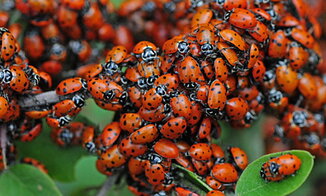
First, however, consider this common question: Why are they called ladybugs? Well, they belong to the family Coccinellidae. Their name originated during the Middle Ages when farmers were battling insects destroying their crops. Being Catholic, the farmers prayed to the Virgin Mary for help. Not long after, the ladybugs arrived in time to chow down and save the crops. First, they were called The Beetles of Our Lady, but it was shortened to ladybugs.
Facts and Myths
Being the diva of the pollinators, many interesting myths exist regarding ladybugs. Still, the facts are quite interesting in themselves.
Did you know they can fly up to 37 miles per hour? Considering they beat their wings 85 times per second, it’s not surprising!
Four states in the United States chose this cute little pollinator as their state insect.
Their outer shell, the Elytra, is made of the same material, Chitin, as your fingernails.
The ladybug doesn’t see so well, so their antennae are very important. The antennae help them smell, taste, and feel their way around to find their dinner.
When ladybugs emerge from the pupa, they have no spots. It takes about half a day for the spots to appear. Some say that the number of spots tells its age. Not true. The spots indicate its species, not its age. However, the spots do fade as they get older. A ladybug is classified as a Senior Citizen anywhere from one to two years.
Those widely held yet false beliefs about ladybugs range from luck to love to sorrow. If you’re looking for a good luck omen, some say the ladybug is the answer. If a ladybug lands on you, according to myth, you get to make a wish. Now, here is where the number of spots is said to serve a different purpose. They reveal how many months or years it will be before your wish becomes a reality!
Remember the connection to the Virgin Mary? Well, ladybugs with seven spots, particularly dark ones, are said to represent the seven sorrows Mary went through.
Finally, seeing a ladybug in a moment of sorrow or struggle is supposed to mean that the one you’ve lost is looking out for you even after their death.
The Ladybug’s Real Calling
Like most pollinators, ladybugs pick up pollen when encountering flowers and spread it to other flowers. They sometimes eat nectar but mainly seek insects because they are carnivores.
So, besides being pollinators, ladybug larvae and adults are excellent pest controllers. You should never try to eliminate them with pesticides. They eat almost 24/7. They consume insects such as aphids, mites, scale insects, and whiteflies that are harmful to crops and small gardens while leaving the plants unharmed.
One exception to the beneficial insect label is the Epilachninae, sometimes known as the Vegetarian. It is a subfamily of the Coccinellidae. Their biology is different from those ladybugs with which we are most familiar. Instead of being carnivores, they are mainly leaf-feeding herbivores, which means they can be classified as crop pests.
How Do Ladybugs Defend Themselves?
Predators are pretty much a constant in nature, and it’s no different for ladybugs. Birds, tree frogs, dragonflies, parasitic wasps, assassin bugs, robber flies, and Joro spiders are examples of those who eat ladybugs. Strangely enough, there’s even a fungus that attacks ladybugs. It is known as Hesperomyces virescens and is a parasite of the alien species, the Asian Lady Beetle, which is immune to the parasite. Hesperomyces-infected ladybugs suffer increased mortality rates.
Under most circumstances, their stinky chemical called pyrazine is their greatest defense against predators. Their brightly-colored bodies warn predators that it is poisonous, even though it’s not. Their third defense is playing dead until the danger passes.

The Asian Lady Beetle, sometimes known as the Asian harlequin ladybird is native to eastern Asia. It was introduced into Europe and North America by farmers to control aphids.
When you buy ladybugs from the garden supply store, you are usually getting the invasive lady beetle species. So please, do not purchase ladybugs. Instead, plant the flora that attracts the native variety.
In many places in the United States, Asian lady beetles have destroyed the native ladybug by infesting them, outcompeting them for resources, and eating them.
Ladybugs and Asian lady beetles may look alike, but key differences can help tell them apart. Asian lady beetles are slightly larger than ladybugs. All ladybugs are bright red with black spots, while the color of Asian lady beetles varies from red to orange. Ladybugs have a round or oval shape. Asian lady beetles are usually a little longer, and the head or snout is more pointed.
The easiest way to tell them apart is the head. Ladybugs have mostly black heads with small white markings that sometimes resemble cheeks. These are found only on the sides of their heads. Most Asian lady beetles have a small, dark marking shaped like an M or W on the whitish area behind the head. This marking varies in size and shape but is always present.
Although the two look similar, that’s where the similarities end. Ladybugs are highly beneficial, harmless, and do not bite nor congregate in large groups.
On the other hand, Asian lady beetles are considered a true pest. Unlike ladybugs, they will gather in large groups and leave a yellow, foul-smelling liquid on surfaces where they congregate. Ladybugs hibernate during the cold weather, whereas lady beetles are attracted to bright colors and like to overwinter in our nice warm homes. Once inside, they congregate in dark, secluded places for warmth, including attics, crawl spaces, closets, and storage areas. They particularly like hiding behind framing and siding.
Instead of crushing any beetles you find, vacuum them and dispose of the bag. Then, use soapy water to clean the surfaces where they congregate. They aren’t dangerous but can be extremely messy.
Unfortunately, the bad guys are here to stay, but we can stop the importation of the alien species by not purchasing them and destroying any that we find.
Ladybugs are the good guys. So keep an eye out for these voracious predators and thank them for the great work they do by providing habitat and do not use pesticides!
 RSS Feed
RSS Feed

